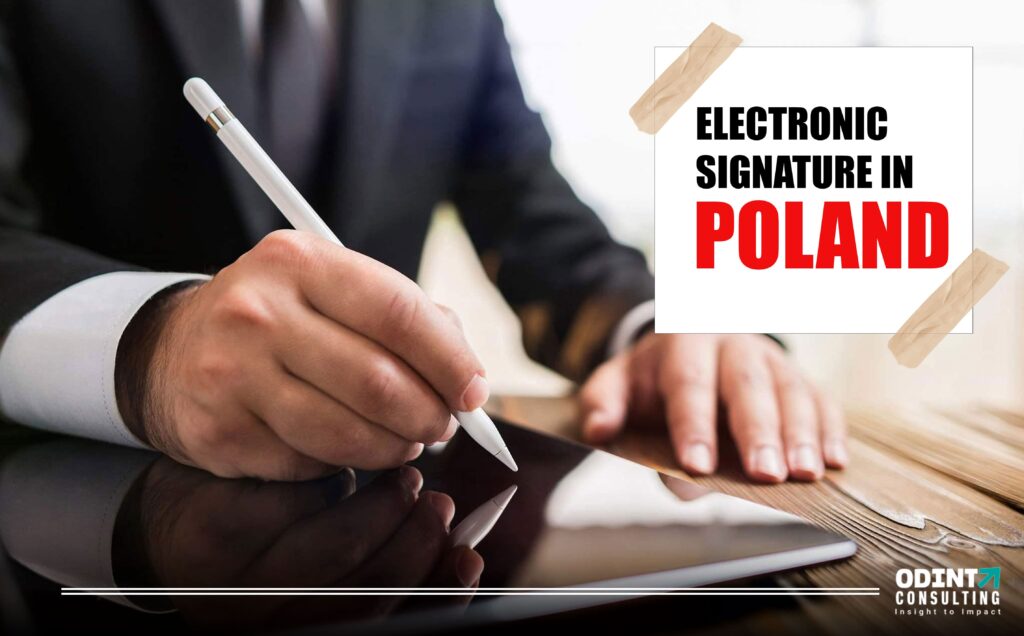
Overview: Electronic Signature in Poland 2022
A handwritten agreement is not necessary for a contractual obligation in Polish legislation. Contracts are normally lawful whether properly qualified sides consent orally, digitally, or in a paper form documentation, unless the law needs a specific form to complete a fixed financial. Polish law stipulates different basic requirements relying on the kind of agreement. Penalties for failing to follow the requisite formalities differ, they might invalidate the contract or render some contractual consequences useless. If Polish law does not demand the use of a printed language, the “documentation structure” will suffice.
Although Polish law stipulates that a handwritten form with an ink signature is required, a certified electronic signature may be substituted. This is conditioned on either party agreeing to use the electronic version and, in some cases, technological restrictions. Certified electronic signatures will not function if the law needs a more robust form. The participants may be required to submit evidence in a case to confirm the identity, legitimacy, and validity of an agreement in order to prove its validity.
Electronic Signature in Poland
On July 1, 2016, the Regulation on digital identity and fund transfer for electronic transfers in the domestic markets came into effect. The European Union’s 28 sovereign states are immediately affected by the eIDAS Directive, which replaced the previous eSignatures Act.
The eIDAS Regulation, which is technology-neutral, establishes three types of electronic signatures. An electronic signature cannot be refused legal effect or acceptance as evidence in court proceedings because it is in digital form or does not meet the specifications of a QES. A QES acknowledged in one EU Member State is likewise recognized in the other EU Member States since it has the same legal impact as a handwritten signature. Recital 49 gives national laws the authority to specify which types of electronic signatures are necessary for particular situations.
The eIDAS Law in Poland is followed by the Law on Security and Digital Identifying Solutions of September 5, 2016, which covers basic regulations on digital certificates in Poland. The Act clarified some federal standards and eliminated sections that did not comply with the eIDAS Law in order to achieve conformity with the eIDAS Regulation in a variety of Polish laws.
Scenarios where the use of Standard Electronic Signature (SES) is appropriate
- Purchase orders, order verifications, receipts, shipping supporting documents, technical handbooks, and guidelines with the exception of customer credit facilities are all examples of customer contracts, such as emerging store account opening documents, selling aspects, service terms, and software licenses with the exception of unique licenses.
- Apart from exclusive licenses, property licenses, especially software licensing
- Contracts for both home and industrial leases are available.
- Non-disclosure contracts, sales orders, purchase recognitions, bills, and other empirical economic, as well as sales agreements, licensing agreements, and contractual arrangements, are examples of business contracts between business organizations in Poland.
The scenario where other types of Electronic Signature can be put into use
- Non-disclosure contracts, staff invention contracts, and confidentiality notifications are examples of HR papers that are subject to prosecution law as opposed to the Employment Act.
- Unique license to patents (art. 76.1, art. 100.1, art. 118.1, and art. 163.1 of the Intellectual Property Ownership) or license to IP rights (art. 76.1, art. 100.1, art. 118.1, and art. 163.1 of the Economic Property Ownership) (art. 67.5 of the Copyright Act)
- QES – a statement of will that must be in writing (Art. 78 of the Civil Code)
- Copyrights (art. 12.2 of the Industrial Property Law) or intellectual property ownership (art. 12.2 of the Industrial Property Law) (art. 53 of the Copyright Act).
Use Cases that are not totally appropriate for electronic signature or digital transaction management

Handwritten signatures or traditional notarization operations, which are not largely consistent with electronic signatures or online transaction administration, are examples of conditions that are deliberately banned from digital format methods or that have specific restrictions.
Handwritten:
HR papers such as employment agreements, compensation documentation, and terminating notifications (art. 29 2 of the Labor Code), as well as any other documentation requiring an ink signing under the Labour Relations act. Whereas the regulations of the Civil Code apply to employee engagement (art. 300 of the Civil Code), the Chief Labour Information commissioner, the organization that governs and controls mechanisms for the commemoration of Polish labor legislation, currently does not permit the use of any kind of cloud signature in employee engagement where an ink confirmation is needed. As a result, ink signatures are necessary for such papers.
Real estate deals:
Uses the common art. 158 of the Civil Code.
Hand or notarized:
Intends, marital agreements (art. 1 Polish Family and Guardianship Code), hereditary contractual arrangements (art. 950, art. 981 (1), and art. 1037 para. 2 of the Civil Procedure code), agreements suspending inherited wealth (art. 1048/1049/1050 of the Civil Code), and hereditary revenues (art. 1048/1049/1050 of the Civil Code) are all examples of child custody records that can be written by hand or notarized (art. 1052 para 3 Civil Code)
Notarization:
Documents of formation for limited partnerships (art. 106), partnerships share capital (art. 131), private limited corporations (art. 157 2), and cooperative corporations (art. 301 2 of the Commercial Companies Code) are notarized.
Purchase of interests, transference or leasing of an entity, or the formation of an easement on it (art. 75 (1) Civil Code).
AES stands for “advance digital message,” which is a sort of an electronic signature that meets the required criteria:
- It is related to the signature in a distinctive manner.
- It has the ability to recognize the signatories.
- It is formed by procedures that are solely controlled by the signing.
- It’s connected to other digital information in such a way that any changes to it may be noticed.
A QES is a specialized eSignature system that has been recognized as ‘trained’ by either the administration or a company hired by the government after meeting the state’s specific requirements, including employing a protected strong authentication mechanism.
Local Technology Standards

Poland, as a Tiered could signature legislative model jurisdiction, recognizes the notion of a Certified Electronic Signature, which requires separate authentication by an authorized certifying authority for the identities. Although certified eSignature is only needed by law for certain kinds of transactions. In order to specify the technical criteria for a QES, Poland, as a member of the European Union, uses European Telecommunication services and Specifications Organization technologies.
Furthermore, as of 1 July 2018, the SHA-1 acronyms feature technique which is used for certified eSignature, AES, or modern automation seals should be replaced by the SHA-2 acronyms feature technique if technological limitations arising from executive acts are published. According to eIDAS Regulation, “910/20141 prevent the use of this abbreviated functionality.”
Poland, along with other European Union nations, publishes a readily viewable database of monitoring organizations for certified and trained providers under EU Regulation 1999/93/EC on Electronic Signatures.
FAQ’s
You must sign when you see the signature of the signatories on the paper. To achieve these standards, considerable caution and knowledge of how the equipment in question works will be required.
An electronic signature is a sort of digital message that enables the signatory to substantiate their claims using a unique Signature based on a certification. In most cases, an electronic document is given by an autonomous Certification Body, which confirms the signer’s authenticity before providing the certification.
